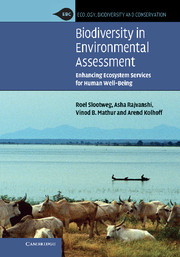Book contents
- Frontmatter
- Contents
- List of contributors
- Foreword
- Preface
- List of abbreviations
- Part I Setting the stage
- 1 Introduction
- 2 Interpretation of biodiversity
- 3 Biodiversity conservation and development: challenges for impact assessment
- Part II Assessment tools
- Part III Emerging issues
- Epilogue – Topics in need of further elaboration
- Annex: valuation of ecosystem services: influential cases
- References
- Index
2 - Interpretation of biodiversity
Published online by Cambridge University Press: 05 July 2014
- Frontmatter
- Contents
- List of contributors
- Foreword
- Preface
- List of abbreviations
- Part I Setting the stage
- 1 Introduction
- 2 Interpretation of biodiversity
- 3 Biodiversity conservation and development: challenges for impact assessment
- Part II Assessment tools
- Part III Emerging issues
- Epilogue – Topics in need of further elaboration
- Annex: valuation of ecosystem services: influential cases
- References
- Index
Summary
Introduction
A multitude of tools and techniques are currently used by companies, governments, certifying agencies, and the like, to predict, measure, or report on the human impacts on biodiversity. Environmental impact assessment (EIA) and strategic environmental assessment (SEA) are the focus of attention in this book, but other instruments exist, such as environmental audits, sustainability reporting, and certification schemes. These instruments are not always based on an unambiguous interpretation of biodiversity (Slootweg, 2005). A rapid comparison of the objectives of the Convention on Biological Diversity (CBD) with a number of biodiversity-related methods for certification and assessment shows that no one instrument addresses all aspects of biodiversity as defined by the CBD. General omissions include: (i) a partial focus on only one level of diversity, mostly the species level and often ecosystem level, but hardly ever the genetic level of diversity; (ii) a focus on either conservation of biodiversity, and sometimes on sustainable use, but largely overlooking the third objective of the CBD on equitable sharing of revenues obtained from biodiversity, and never including all three objectives simultaneously; (iii) a general lack of identification and involvement of stakeholders; and finally, (iv) a lack of attention to the potential positive effects of human activities on biodiversity (opportunities for enhancement) (Slootweg et al., 2003).
- Type
- Chapter
- Information
- Biodiversity in Environmental AssessmentEnhancing Ecosystem Services for Human Well-Being, pp. 14 - 58Publisher: Cambridge University PressPrint publication year: 2009
- 4
- Cited by



